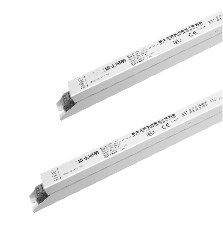Rapid start electronic fluorescent ballast apply a low filament voltage to preheat the cathodes. Simultaneously, a starting voltage (lower than that used in instant start) is also applied to strike the arc. When the cathodes are hot enough, the lamp will strike. The filament voltage continues to be applied throughout the operation of the lamp. Rapid start ballasts appear to have a slight turn on delay compared to instant start. They will typically not be able to start lamps reliably under 50 degrees F.
Most fluorescent fixtures with two or more lamps are known as "rapid start". In this system, there is no starter. Instead, the ballast keeps a low flow of current running through the filaments at all times or during the start-up period, and uses a capacitor or other techniques to start the lamp by ionizing the gas, which is another way to reduce the initial resistance of gas to a flow of electrical current.
Most of these rapid-start systems establish a brief but high voltage potential between one or both cathodes of the lamp and a metal surface in the fixture that must be within a certain distance (usually less than 0.5 inches) of the lamp along its full length. Some lamps that are formed into a "U" shape actually have a conductive metal stripe painted on the glass tubing to assist in the starting process.
By ionizing the gas, the ballast is able to get a low current flow of electricity moving through the lamp, which causes the lamp to glow dimly. However, this feeble flow of current does start heating the gas throughout the length of the lamp, and the light being produced creates even more ionization, both of which work to lower the resistance of the gas further. Meanwhile, the ballast is providing current to the filaments at each end of the lamp to further assist the starting process. Combined, all of these things work to rapidly lower the electrical resistance of the gas and encourage the lamp to draw more current and become brighter. This is why rapid start fixtures light almost instantly (but dimly), and then take a few more seconds to achieve most of their normal operating brightness.
The reasons for choosing rapid-start ballasts in these two cases are:
A rapid start ballast will start a lamp by first heating the cathode and will maintain a constant arc across the cathode to maintain the heat necessary for proper operation. This is mandatory for any dimming operation. Dimming is impossible using an instant-start ballast.
The rapid-start electronic ballast is easier on the cathode in the starting mode; when there are many on-off cycles because occupancy sensors control the lights, lamps tend to be longer lived with rapid-start ballasts. Instant-start ballasts, in this situation, are believed to cause premature failure of the lamps because of the high voltage they use to "jump start" the lamps. This high-voltage blasting of the cathode causes sputtering—clumps of tungsten are blown off the cathode and coat the ends of the lamp, causing them to appear black. This blackening occurs with all lamps as they age, but it occurs more rapidly when an instant-start ballast is in operation and the lamp is turned off and on many times a day.

Metal Halide Ballasts | High Pressure Sodium Ballasts | Fluorescent ballasts | Gear Tray
Links: Porcelain lamp socket | Mercury Vapor Ballast | Light bulb socket
Xml Copyright: @2012-2020 James Lighting Electronic Co.,Ltd